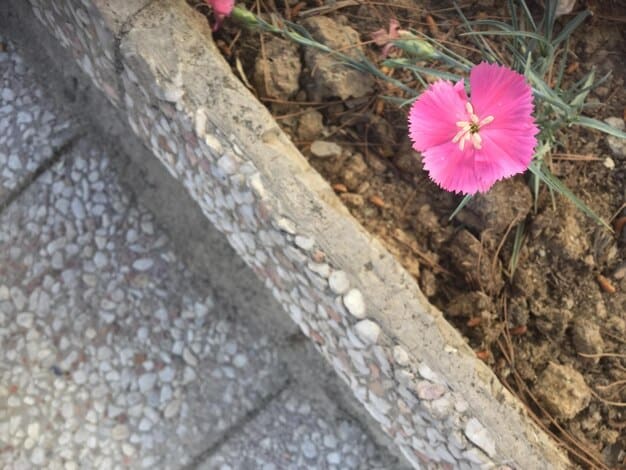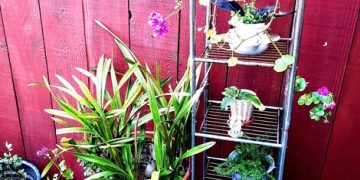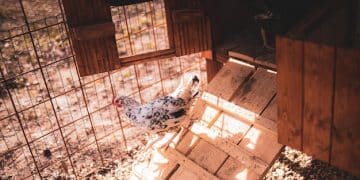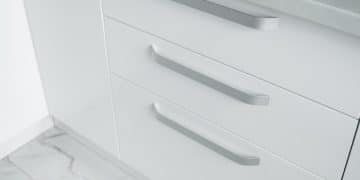Build a Raised Garden Bed for Improved Soil Drainage: Beginner’s Guide

A raised garden bed improves soil drainage by elevating the growing area, preventing waterlogging and promoting healthier root systems, which is crucial for successful gardening, especially in areas with poor soil quality.
Want to improve your garden’s health and yield? Learning how to build a raised garden bed for improved soil drainage is a fantastic DIY project for beginners!
Why Build a Raised Garden Bed for Drainage?
Raised garden beds offer numerous benefits, but one of the most crucial is improved soil drainage. Whether you’re dealing with heavy clay soil or a low-lying area prone to waterlogging, a raised bed can make a significant difference. But why is drainage so important for your garden?
Poor soil drainage can lead to a host of problems, including root rot, nutrient deficiencies, and stunted growth. By building a raised bed, you create an elevated growing environment that allows excess water to drain away quickly and efficiently.
The Impact of Poor Drainage
Understanding the negative effects of poor drainage is key to appreciating the value of raised beds. Here’s a closer look at what can happen when your soil doesn’t drain properly:
- Root Rot: Waterlogged soil creates an anaerobic environment, which encourages the growth of harmful fungi that cause root rot.
- Nutrient Deficiencies: Excess water can wash away essential nutrients, leaving your plants starved and unable to thrive.
- Stunted Growth: Plants struggling with poor drainage will often display stunted growth, yellowing leaves, and reduced yields.
Building raised beds ensures that plants receive the right amount of moisture, promoting healthier growth and more abundant harvests.

Planning Your Raised Garden Bed
Before you start hammering and sawing, it’s essential to plan your raised garden bed carefully. Consider factors like the size, location, and materials you’ll need. A well-thought-out plan will save you time and effort in the long run.
Choosing the right location is critical for sunlight exposure and convenience. Ideally, your raised bed should receive at least six hours of sunlight per day and be easily accessible for watering and maintenance.
Choosing the Right Materials
The materials you use to build your raised bed can impact its longevity and aesthetic appeal. Here are some popular options:
- Cedar: Naturally rot-resistant and aesthetically pleasing, cedar is a popular choice for raised beds.
- Redwood: Similar to cedar, redwood is durable and resistant to decay, making it a long-lasting option.
- Untreated Pine: A more affordable option, untreated pine can last for several years if properly maintained.
- Concrete Blocks: Durable and readily available, concrete blocks offer a sturdy and low-maintenance option.
Each of these materials has different pros and cons in terms of cost, durability and environmental impact. Consider your best option based on your needs before starting the project.
Step-by-Step Guide to Building Your Raised Bed
Now that you’ve planned your raised garden bed, it’s time to get your hands dirty! This step-by-step guide will walk you through the process of building a raised bed that promotes excellent soil drainage.
Start by gathering your materials and tools. You’ll need lumber, screws, a drill, a saw, landscape fabric, gravel, and a well-draining soil mix. Having everything on hand will streamline the building process.
The Construction Process
Follow these steps to build your raised garden bed:
- Cut the Lumber: Cut the lumber to the desired length, creating the frame for your raised bed.
- Assemble the Frame: Use screws to assemble the frame, ensuring it’s sturdy and square.
- Line the Bed: Line the interior of the bed with landscape fabric to prevent soil erosion and weed growth.
- Add Drainage Layer: Add a layer of gravel to the bottom of the bed to promote drainage.
- Fill with Soil: Fill the bed with a well-draining soil mix, leaving a few inches of space at the top.
By taking the project step-by-step, it should be a piece of cake to have your raised garden bed built!
Enhancing Drainage: Tips and Tricks
While building a raised bed inherently improves drainage, there are additional steps you can take to further enhance it. Consider these tips and tricks to ensure your plants thrive in a well-drained environment:
Select plants best suited to the soil, moisture, and sunlight conditions you have available. It is best not to try and plant water-loving plants in soil that is well-draining. You can select drought-resistant plants instead.
Additional Drainage Strategies
- Add Organic Matter: Incorporate compost, peat moss, or other organic matter into your soil mix to improve drainage and nutrient retention.
- Use a Well-Draining Soil Mix: Choose a soil mix specifically designed for raised beds to ensure proper drainage and aeration.
- Install Drainage Pipes: For areas with particularly poor drainage, consider installing perforated drainage pipes at the base of the bed.
You can never have too many tools at your disposal! Selecting the right strategies for drainage will assist in the long-term health for your garden.

Choosing the Right Soil Mix
The type of soil mix you use in your raised garden bed is crucial for drainage and plant health. A well-draining soil mix will allow excess water to flow freely, preventing waterlogging and promoting healthy root growth.
Look for a mix that contains a combination of topsoil, compost, and perlite or vermiculite. These ingredients work together to provide good drainage, aeration, and nutrient retention.
Understanding Soil Components
Here’s a breakdown of common soil amendment and components:
- Topsoil: Provides a base for plant growth and contains essential minerals.
- Compost: Adds organic matter, improves drainage, and provides nutrients.
- Perlite: Increases aeration and drainage, preventing soil compaction.
- Vermiculite: Retains moisture and nutrients, making them available to plants.
Selecting the right soil mix can vary depending on different factors. These include climate and plant types. Do some research and find what fits your garden best!
Maintaining Your Raised Garden Bed
Once your raised garden bed is built and planted, it’s essential to maintain it properly to ensure long-term health and productivity. Regular maintenance will help prevent drainage issues, nutrient deficiencies, and other common problems.
Water your plants deeply but infrequently, allowing the soil to dry out slightly between waterings. This encourages deep root growth and prevents waterlogging.
Tips for Long-Term Garden Health
- Monitor Soil Moisture: Use a moisture meter or your finger to check the soil moisture level before watering.
- Fertilize Regularly: Apply a balanced fertilizer according to the package instructions to provide essential nutrients.
- Weed Control: Regularly remove weeds to prevent them from competing with your plants for nutrients and water.
With a proactive approach to raised garden bed maintenance, this DIY project should give your green thumb a major advantage!
| Key Point | Brief Description |
|---|---|
| 🌱 Improved Drainage | Prevents waterlogging and promotes healthier root growth. |
| 📏 Planning is Key | Choose the right location and plan your bed’s size and materials. |
| 🔨 Construction Steps | Assemble the frame, line it with fabric, and add a drainage layer. |
| 🌿 Soil Mix Matters | Use a well-draining mix with topsoil, compost, perlite, or vermiculite. |
Frequently Asked Questions
▼
Good drainage prevents water from accumulating around plant roots, which can lead to root rot and nutrient deficiencies. Proper drainage ensures healthier, more productive plants.
▼
A mix of topsoil, compost, and perlite or vermiculite works well. This combination provides the necessary nutrients and allows excess water to drain effectively, promoting root health.
▼
Add organic matter like compost to the soil to improve its structure. You can also incorporate perlite or vermiculite to increase aeration and drainage capacity, helping to prevent waterlogging.
▼
Avoid using heavy clay soil or materials that can compact easily. These can impede water flow and lead to drainage problems. Proper material selection is important for ideal results!
▼
Water deeply but infrequently, allowing the soil to dry out slightly between waterings. Overwatering can saturate the soil, negating the drainage benefits of the raised bed structure.
Conclusion
Building a raised garden bed for improved soil drainage is a straightforward project that can significantly enhance your gardening success. By following these steps and tips, you can create a thriving garden environment where your plants will flourish.





